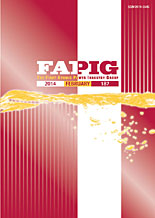|
Ϊ@@
‘ ΰξ
ΰιΖΜGlM[}lWgΜσ΅Ζ¬nxfΜρΔ
( 3 )
²‘@€
‘ π@@ΰ
2014NΜoΟW] ( 7 )
{θaM
‘ Π@@ξ
ΐp·KXFΜFSέv (13)
μ³Ύ / cΰVEY / ε΄κF / ͺ{Ύu
©‘Μό―Β«ϊΛόΔe[^VXeΜ\z
(18)
ΝϋNN / μpΊ / SΪΨKY / Oμ@C
ϊ{εkΠpό¨ΔpFΜΐΡΖ€JΙΒ’Δ
(23)
ηγ@Ί / ά / ²‘Nm
JT-60SAp_Co[^^[QbgΜ»μ
(28)
RcOκ / Nδ^‘ / Ί½r
FAPIGΜ@\ (32)
FAPIGM[εW (36)
\fUCF{’ό
@
CONTENTS
‘ Domestic Information
Realities of Energy Management of Japanese Company, and Proposal of
Maturity Model ( 3 )
K. Sato
‘ Commentary
Economic Outlook for 2014 ( 7 )
K. Miyazaki
‘ Introduction
Core Design for Commercial-size High Temperature Gas-cooled Reactor
(13)
M. Nakano / Y. Tazawa / K. Ohashi / F. Okamoto
Establishment of the Remote Radiation Monitoring System in Environment
for Local Municipalities (18)
T. Kawaguchi / H. Noushi / Y. Domeki / O. Maekawa
Production and Development of Incinerator System for the Great East
Japan Disaster Waste (23)
R. Chishiro / S. Takenaka / K. Satoh
Manufacturing of Divertor target for JT-60SA (28)
H. Yamada / S. Sakurai / S. Nakamura
Cover DesignFSatomi Sugimoto
@
SYNOPSES
Ken Sato
Realities of Energy Management of Japanese Company, and Proposal of
Maturity Model
FAPIG No. 187 pp.3 to 6 (2014)
Energy management is one of the most important agendas for business
management.
Here we show the result of enterprise questionnaire and the maturity
model of the energy management conducted JEITA (Japan Electronics and
information Technology Industries Association).
KEYWORDSFenergy management, maturity model, ISO50001, EnPI, energy
performance indicator
Masaaki Nakano, Yujiro Tazawa, Kazutaka Ohashi, Futoshi Okamoto Core
Design for Commercial-size High Temperature Gas-cooled Reactor
FAPIG No. 187 pp.13 to 17 (2014)
High temperature gas-cooled reactors (HTGR) have enhanced passive safety
characteristics. Even if in the case of "station black out" where
all electric power supplies are not available, HTGR can cool its decay
heat from the core. In this paper, the core design and safety assessment
are performed for commercial-size 600MWth prismatic type HTGR. Power
density distributions in the core that are obtained with nuclear analyses
are applied to temperature analyses in normal operation, and in the
depressurization accident condition where no active cooling devices
are assumed to work. In the results, the fuel temperature in the normal
operation and the accident condition are satisfied its criteria respectively,
that proves its superior safety feature without any active devices.
KEYWORDSFHTGR, core design, safety assessment, decay heat removal,
passive safety
Tetsuaki Kawaguchi, Hideaki Noushi, Yukio Domeki, Osamu Maekawa Establishment
of the Remote Radiation Monitoring System in Environment for Local Municipalities
FAPIG No. 187 pp.18 to 22 (2014)
The Remote Radiation Monitoring System in Environment is the system
that provides the general public with measurement data of ambient dose
at the boundaries of monitoring areas surrounding a nuclear facility.
The data measured and monitored continuously for 24 hours a day, 365
days a year is sent to key disaster- prevention facilities such as nuclear
environmental monitoring facilities and off-site facilities administered
by local municipalities, prefectural office and municipal office. Such
dissemination of information enables local residents to obtain those
data via websites, etc.
Fuji Electric has established the Remote Monitoring System in Environment
that measures ambient dose in the entire area of Kagoshima prefecture.
By multiplexing of satellite communication data transmission channel,
ensuring backup power via emergency generator and multiplexing server
system, the system is capable of responding to disasters, measuring
continuously even at the time of large-scale disaster. Also, Fuji Electric
has applied the latest IT technologies to the system. The following
description includes installation of a large multiscreen LCD at disaster
countermeasures office in the prefectural office, realization of outdoor
monitoring task using a tablet type terminal device, and other technologies
used for this system.Measurement
Ryo Chishiro, Satsuki Takenaka, Kouji Satoh
Production and Development of Incinerator
System for the Great East Japan Disaster Waste
FAPIG No. 187 pp.23 to 27 (2014)
The Great East Japanese earthquake and tsunami generated a great deal
of disaster wastes in Miyagi, Iwate and Fukushima prefecture, especially
coast area.
In Miyagi and Iwate almost treatments of disaster wastes are currently
about to be finished using some temporary incinerators.
On the other hand in Fukushima the wastes containing radioactive materials
prevented treating in early-stage. Japanese government prepared the
domestic law to support radioactive wastes treatment using incinerator.
In 2014 they have the plan to install some incinerator within 20-km
area and set out the treating operation.
Here we present our two incinerators installed in Miyagi and our R&D
for treatment radioactive waste in Fukushima.
KEYWORDSFdisaster waste, incinerator, waste treatment
Hirokazu Yamada, Shinji Sakurai, Shigetoshi Nakamura
Manufacturing of Divertor target for JT-60SA
FAPIG No. 187 pp.28 to 31 (2014)
The activity of "Broader approach (BA)" is carried out under the Japan-EU
collaboration towards the early realization of nuclear fusion energy,
and the construction of JT-60SA (Super Advanced) has been started as
a part of BA.
Divertor target of JT-60 consisted of carbon fiber composite tiles bolted
on heat sink plate. Due to extension of plasma heating power and pulse
duration, divertor target for JT-60SA has to be changed to the concept
of carbon fiber block jointed to cooling tube of Cu-alloy for active
cooling.
Brazing joint between the carbon block and cooling tube is easy to cause
joint defect due to the difference in the coefficient of linear expansion
of a material. The joint defect reduces heat removal performance of
the target.
On the occasion of the apparatus manufacture concerned, the structural
improvement resolved those problems.
This paper reports the contents of a structural improvement in the divertor
target manufacturing for JT-60SA, etc.
KEYWORDSFPlasma facing component, Divertor, Brazing, CFC
|
![]()
